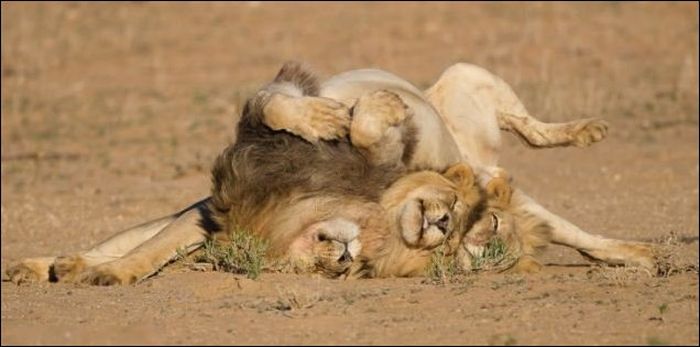|
|
Three Lazy Lions
|
The presence of lions at the Tower of London was intermittent, being restocked when a monarch or his consort, such as Margaret of Anjou the wife of Henry VI, either sought or were given animals. Records indicate they were kept in poor conditions there in the seventeenth century, in contrast to more open conditions in Florence at the time. The menagerie was open to the public by the eighteenth century; admission was a sum of three half-pence or the supply of a cat or dog for feeding to the lions. A rival menagerie at the Exeter Exchange also exhibited lions until the early nineteenth century. The Tower menagerie was closed down by William IV, and animals transferred to the London Zoo which opened its gates to the public on 27 April 1828.
The wild animals trade flourished alongside improved colonial trade of the nineteenth century. Lions were considered fairly common and inexpensive. Although they would barter higher than tigers, they were less costly than larger, or more difficult to transport animals such as the giraffe and hippopotamus, and much less than pandas. Like other animals, lions were seen as little more than a natural, boundless commodity that was mercilessly exploited with terrible losses in capture and transportation. The widely reproduced imagery of the heroic hunter chasing lions would dominate a large part of the century. Explorers and hunters exploited a popular Manichean division of animals into "good" and "evil" to add thrilling value to their adventures, casting themselves as heroic figures. This resulted in big cats, always suspected of being man-eaters, representing "both the fear of nature and the satisfaction of having overcome it."
Lions were kept in cramped and squalid conditions at London Zoo until a larger lion house with roomier cages was built in the 1870s. Further changes took place in the early twentieth century, when Carl Hagenbeck designed enclosures more closely resembling a natural habitat, with concrete 'rocks', more open space and a moat instead of bars. He designed lion enclosures for both Melbourne Zoo and Sydney's Taronga Zoo, among others, in the early twentieth century. Though his designs were popular, the old bars and cage enclosures prevailed until the 1960s in many zoos. In the later decades of the twentieth century, larger, more natural enclosures and the use of wire mesh or laminated glass instead of lowered dens allowed visitors to come closer than ever to the animals, with some attractions even placing the den on ground higher than visitors, such as the Cat Forest/Lion Overlook of Oklahoma City Zoological Park. Lions are now housed in much larger naturalistic areas; modern recommended guidelines more closely approximate conditions in the wild with closer attention to the lions' needs, highlighting the need for dens in separate areas, elevated positions in both sun and shade where lions can sit and adequate ground cover and drainage as well as sufficient space to roam.
There have also been instances where a lion was kept by a private individual, such as the lioness Elsa, who was raised by George Adamson and his wife Joy Adamson and came to develop a strong bond with them, particularly the latter. The lioness later achieved fame, her life being documented in a series of books and films.
|
|









